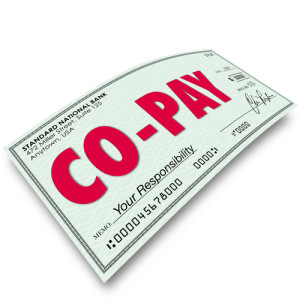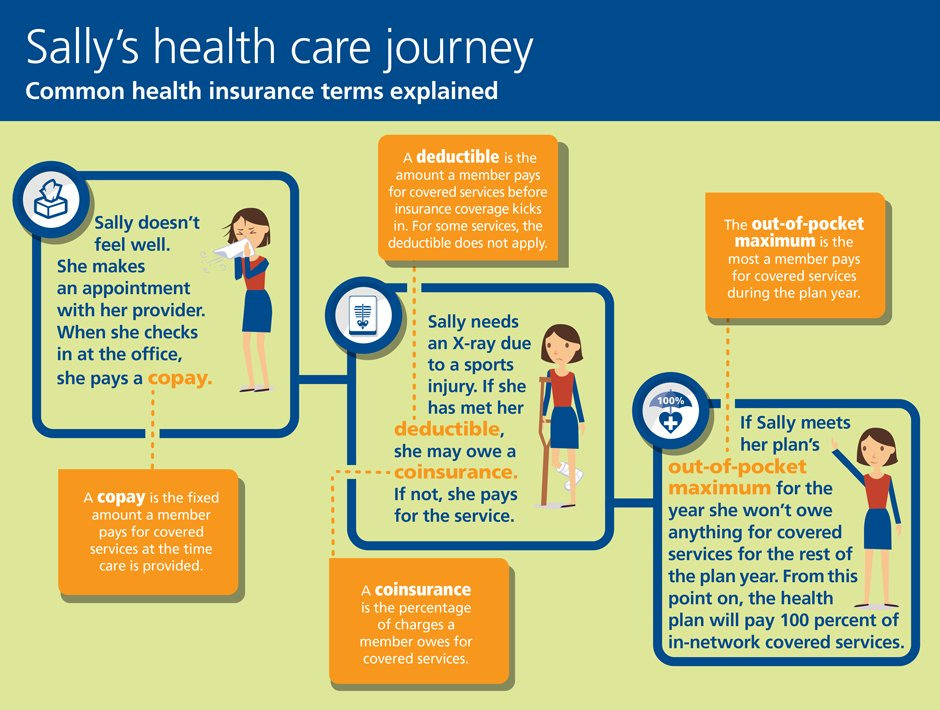What is the meaning of Co-pay in Health Insurance? Copay or Co-payment refers to a fixed amount of money you need to pay for certain types of treatment when the rest balance amount will be paid to the insurer. The can be a pre-decided amount or a percentage of the total cost of treatment depending on the policy you choose. Copay is a consumer payment for a medical service. The consumer usually pays it at the time the service provider performs their part. It is usually a fixed fee such as a $20 copay for an office visit. The insurance companies often set the copay to represent a small portion of the true cost of a benefit or service.
- Copay Meaning In Health Insurance Coverage
- Health Insurance Co Pays
- What Is Copay In Health Insurance With Example
- What Is Copay In Health Insurance
- Copay Meaning In Health Insurance Definition
- Definition Health Insurance
A copay after deductible is a flat fee you pay for medical service as part of a cost sharing relationship & health insurance must pay for your medical expenses.4 min read
1. Copay After Deductible: Everything You Need to Know2. Deductible: What Is It?
3. Are Coinsurance and Copay the Same Thing?
4. What Is the Difference Between Aggregate and Embedded Deductibles?

Copay After Deductible: Everything You Need to Know
A copay after deductible is a flat fee you pay for medical service as part of a cost-sharing relationship in which you and your health insurance provider must pay for your medical expenses. Deductibles, coinsurance, and copays are all examples of cost sharing. If you understand how each of them works, it will help you determine how much and when you must pay for care.
Copay Meaning In Health Insurance Coverage
Deductible: What Is It?
The amount you pay for medical services before your health insurance starts paying is known as a deductible. For example, if your insurance deductible is $1,500, you will be responsible for paying all of the pharmacy and medical bills until the amount you pay has reached $1,500. At that point, you begin sharing some future costs with the insurance company through copays and coinsurance.
Typically, a health insurance plan with a high deductible will require you to pay fairly inexpensive payments monthly. Although, initially, you will have to pay a significant amount up front if you were to need care. You may consider looking for plans that will pay for some services before you must pay your deductible. If you are mostly healthy, then it may be a good idea to increase your deductible as an easy way to lower your monthly payments or premiums. However, if you do this and then get sick, your medical bills in a year will be high.
Hospitalizations, blood tests, or surgical procedures may be services you pay for annually as part of your health insurance deductible. These services do not include routine care. Usually, preventative checkup services will just require that you make a co-payment. After the deductible has been met, your insurance will cover the expenses.
In a majority of circumstances, neither premiums nor copays count toward your deductible. Examples of health care costs that may count toward your deductible may include the following:

- Chiropractic care
- Hospitalization
- Mental healthcare
- Surgery
- Pacemakers and other medical devices
- Lab tests
- Physical therapy
- MRIs
- Anesthesia
- CAT scans
Are Coinsurance and Copay the Same Thing?
Copay and coinsurance are similar, but coinsurance is a percentage of costs, as opposed to a fixed dollar amount. A percentage of the amount an insurance company will allow a healthcare provider to charge for service gets determined when calculating the amount of a person's coinsurance. It is your share of the medical costs which get paid after you have paid the deductible for your plan.
An example of paying coinsurance and your deductible would be if you have $1,000 in medical expenses and the deductible is $100 with 30 percent coinsurance. You would pay $100 along with 30 percent of the remaining $900 up to your out-of-pocket maximum, which would be the most you would pay in a year.
Not all plans have coinsurance, but you may find plans with cost sharing of 50/50 or 20/80 coinsurance, or other combinations. Usually, if you are making small monthly payments for your plan, you may expect to pay more in coinsurance. Typically, the lower a plan's monthly payments, the more you will pay in coinsurance.
You will be required to pay coinsurance and copays only until you have reached your out-of-pocket maximum. As mentioned above, the amount of the maximum is the most you will pay for covered medical expenses. It includes the total of deductibles, coinsurance, and copays. After you reach the maximum, your covered prescription and medical costs will be paid by your insurance for the remainder of the year.
Some service may require that you pay coinsurance and copay. Copay is typically a fixed fee you pay when you receive medical service, although, the amount is not always the same. It can change depending on the type of care you receive. For example, a visit to the doctor's office may come with a copay of $25, but an emergency room visit may be $200.
If you have prescriptions that need to get filled often or you go to the doctor regularly, you might want to pick a health insurance plan that has low copays for drugs and office visits. If your plan covers an annual checkup in full and other preventative care services, you most likely will not have a copay at all for these visits. Certainly, you will be free of payment obligations if you have reached your out-of-pocket maximum for the year.
High Deductible Health Plans (HDHPs) have a different set of rules when it comes to copays compared to other types of plans. Usually, people with HDHPs must pay their deductible before the insurance will pay for any other services outside of preventative care.
Health Insurance Co Pays
What Is the Difference Between Aggregate and Embedded Deductibles?
When it comes to members of a family plan, it is important to know if you have an embedded or aggregate deductible. An aggregate deductible refers to the amount that must be met for any or all people under the plan before your insurance begins to pay for any medical coverage.
An embedded deductible means the family deductible, but there is also one for each family member. For example, a family plan has a family or overall deductible of $10,000, and the embedded deductible for the individual family member is $5,000. Then, say one person has expenses of at least $5,000; the insurance would cover any further care for the person. If another person gets sick and needs care but the cost is only $1,000, the family will have to pay that amount. There will still be $4,000 necessary for that person's overall deductible. Insurance starts covering medical costs sooner for the individual with an embedded deductible who has large bills than it would for the family to reach the overall deductible.

If you need help dealing with copay after deductible, you can post your legal need on UpCounsel's marketplace. UpCounsel accepts only the top 5 percent of lawyers to its site. Lawyers on UpCounsel come from law schools such as Harvard Law and Yale Law and average 14 years of legal experience, including work with or on behalf of companies like Google, Menlo Ventures, and Airbnb.
Due to medical inflation and the rising cost of healthcare services, the number of people buying health insurance policy has risen significantly today. However, though a lot of people might assume that all medical expenses are covered by health insurance, there are few times or few expenses that are not covered under it. And policyholders have to pay for them from their own pocket. There are several reasons for which this can happen; two of them being copayment or deductible clauses mentioned in their policy.
In this blog, we will tell you what these two terms mean and what is the difference between them.

What Is Copay In Health Insurance With Example
What is a co-payment clause?
Co-payment are times where the insurance companies pay a part of the claim and the other part of the claim is borne by the policyholder.
For example, senior citizen policies often come with co-payment clauses, let’s understand why. Suppose you buy a senior citizen policy for your mother who has a pre-existing illness. Now, different health insurance policies treat it differently. Usually for pre-existing illnesses, insurance companies put a waiting period, a hibernation period during which you cannot claim insurance for that particular illness, for upto three to four years. But for senior citizen policies, the waiting period is usually low, and sometimes there is no waiting period at all. Instead of waiting periods, the insurance company puts a co-payment clause. That is, in case the policyholder is hospitalised, the insurance company bears a part of the cost, and the policyholder pays a part of it.
It is important to note that the premium amount is lower for insurance policies with co-pay clauses as compared to the ones without copay clauses.
What are deductibles?
Deductible is the amount of money that you agree to pay (as per the term and condition) during the claim process.
For example, if you have a deductible clause of Rs 5,000 in your insurance policy, you have to pay this amount, whether the claim amount is Rs 10,000 or Rs 1 lakh. And the rest of the expenses are borne by the insurance company. Deductibles are included in health policies to discourage policyholders to make repeated or very small claims.
Like policies with co-payment clauses, the premium amount for policies with deductible clauses are also lower than the once without deductible clause. .
How co-payment and deductible are different from each other?
Policyholders often get confused between co-payment and deductible because both require them to make payment during the claim process. But these two clauses are completely different from each other. Deductible is a fixed amount, like Rs 5,000 or Rs 10,000, that you are required to pay before the claim process arises. The rest is covered by the insurance company if the amount is within the coverage limit.
What Is Copay In Health Insurance
Meanwhile, in case of a policy with the copayment clause, you will have to bear a portion of the expenses in a 70/30, 40/60 or 80/20 etc. ratio.This ratio is decided between the insurance company and the insurance company and the policyholder.
Let’s suppose you have an insurance plan with a co-pay structure of 70/30. Now, in case the bill amount is Rs 1 lakh, the insurance company will pay Rs 70,000 and you pay Rs 30,000.
Copay Meaning In Health Insurance Definition
Bottom Line
Definition Health Insurance
To avoid confusion about these things and make the claim process smooth, it is important to read the policy paper carefully. Look for the terms and conditions that are stated in it. Learning about such clauses beforehand will help you plan the expenses earlier, rather coming to know about them during the time of payment process.
